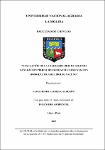Mostrar el registro sencillo del ítem
Evaluación de la calidad de biol de segunda generación producido mediante fermentación homoláctica del biol ig vacuno
| dc.contributor.advisor | Juscamaita Morales, Juan Gabriel | |
| dc.contributor.advisor | Quipuzco Ushñahua, Lawrence Enrique | |
| dc.contributor.author | Flores Calderón, Elvis Hedim | |
| dc.date.accessioned | 2024-01-16T19:54:59Z | |
| dc.date.available | 2024-01-16T19:54:59Z | |
| dc.date.issued | 2023 | |
| dc.identifier.uri | https://hdl.handle.net/20.500.12996/6181 | |
| dc.description | Universidad Nacional Agraria La Molina. Facultad de Ciencias. Departamento Académico de Ingeniería Ambiental, Física y Meteorología | es_PE |
| dc.description.abstract | Se planteó la elaboración de Biol II-G para mejorar las propiedades y valor del biol I-G de vaca, procedente de un biodigestor tubular de 10 m3 el cual registró valores promedio 7.05 de pH y conductividad eléctrica 5.01 dS/m. Para producirlo se realizó la fermentación láctica de éste durante cinco días. Se evaluó el pH,de acidez láctica, características físico-químicas, macronutrientes (N, P, K), micronutrientes (Ca, Mg, Na, Fe, Cu, Zn, Mn y B), metales pesados (Cd, Cr y Pb), agentes microbiológicos (Coliformes fecales, Coliformes totales, E. coli., Salmonella sp.), y la dilución óptima de aplicación en un bioensayo. Previamente se evaluaron nueve mezclas y se seleccionó una óptima: biol de vaca (75 por ciento), consorcio microbiano (15 por ciento) y melaza de caña (10 por ciento). Se trabajó con este tratamiento a escala piloto y se alcanzó un pH de 3.89 a temperatura ambiente y un valor cercano a 1.92 por ciento de acidez láctica (A.L.) al quinto día. El potasio (macronutriente) se incrementó en 58 por ciento mientras el magnesio (micronutriente) se incrementó en 230 por ciento respecto al biol de I-G. La acidificación del proceso fermentativo garantizó la eliminación de patógenos. Mediante un ensayo de fitotoxicidad se determinó que el abono diluido al 0.1 por ciento benefició el crecimiento de las plántulas de lechuga. El abono líquido producido presentó características beneficiosas, acorde con experiencias semejantes: generación de ácido láctico, aporte de nutrientes, inocuidad microbiológica y sin efectos fitotóxicos. Se evitó la emisión de gases de efecto invernadero y otros problemas ambientales al valorizar el residuo. | es_PE |
| dc.description.abstract | The elaboration of Biol II-G was proposed to improve its properties and value of a cow biol I-G from a 10 m3 tubular biodigester which registered pH values on average 7.05 und, electrical conductivity 5.01 dS / m. To produce it, lactic fermentation was carried out for five days. The properties of the obtained product were evaluated such as the level of pH and lactic acidity, the physico-chemical characteristics: macronutrients (N, P, K) and micronutrients (Ca, Mg, Na, Fe, Cu , Zn, Mn and B) and heavy metals (Cd, Cr and Pb), microbiological (Fecal coliforms, Total coliforms, E. coli., Salmonella sp.); and the optimal dilution of application in a bioassay. Previously, nine mixtures to be fermented were tested and an optimal one was selected: cow biol (75 percent), microbial consortium (15 percent) and cane molasses (10 percent). A pilot scale was worked with this treatment and a final pH of 3.89 was reached at room temperature and a lactic acid content close to 1.92 percent lactic acidity (A.L.) on the fifth day. Potassium (macronutrient) increased by 58 percent while magnesium (micronutrient) increased by 230 percent with respect to the biol of I-G. The acidification of the fermentation process ensured the elimination of pathogens and through a phytotoxicity test it was determined that the fertilizer diluted to 0.1 percent favored the growth of lettuce seedlings. The liquid fertilizer produced presented characteristics typical of lactic fermentation and in accordance with similar experiences: generation of lactic acid, supply of nutrients, microbiological safety and without phytotoxic effects. It is highlighted that the material costs were low and the emission of greenhouse gases and other environmental problems was avoided by valuing the waste. | es_PE |
| dc.format | application/pdf | es_PE |
| dc.language.iso | spa | es_PE |
| dc.publisher | Universidad Nacional Agraria La Molina | es_PE |
| dc.rights | info:eu-repo/semantics/openAccess | es_PE |
| dc.rights.uri | https://creativecommons.org/licenses/by-nc-nd/4.0/ | es_PE |
| dc.subject | fertilizante orgánico | es_PE |
| dc.title | Evaluación de la calidad de biol de segunda generación producido mediante fermentación homoláctica del biol ig vacuno | es_PE |
| dc.type | info:eu-repo/semantics/bachelorThesis | es_PE |
| thesis.degree.discipline | Ingeniería Ambiental | es_PE |
| thesis.degree.grantor | Universidad Nacional Agraria La Molina. Facultad de Ciencias | es_PE |
| thesis.degree.name | Ingeniero Ambiental | es_PE |
| dc.subject.ocde | pendiente | es_PE |
| renati.author.dni | 72111760 | es_PE |
| dc.publisher.country | PE | es_PE |
| dc.type.version | info:eu-repo/semantics/publishedVersion | es_PE |
| renati.advisor.orcid | https://orcid.org/ 0000-0002-2198-0461 | es_PE |
| renati.advisor.orcid | https://orcid.org/ 0000-0002-7282-0409 | es_PE |
| renati.advisor.dni | 25811302 | es_PE |
| renati.advisor.dni | 09675453 | es_PE |
| renati.type | https://purl.org/pe-repo/renati/type#tesis | es_PE |
| renati.level | https://purl.org/pe-repo/renati/level#tituloProfesional | es_PE |
| renati.discipline | 521066 | es_PE |
| renati.juror | Visitación Figueroa, Lizardo | |
| renati.juror | Villegas Silva, Elvito Fabián | |
| renati.juror | Vela Cardich, Rosemary |
Ficheros en el ítem
Este ítem aparece en la(s) siguiente(s) colección(ones)
-
CIE-IA Tesis [303]





